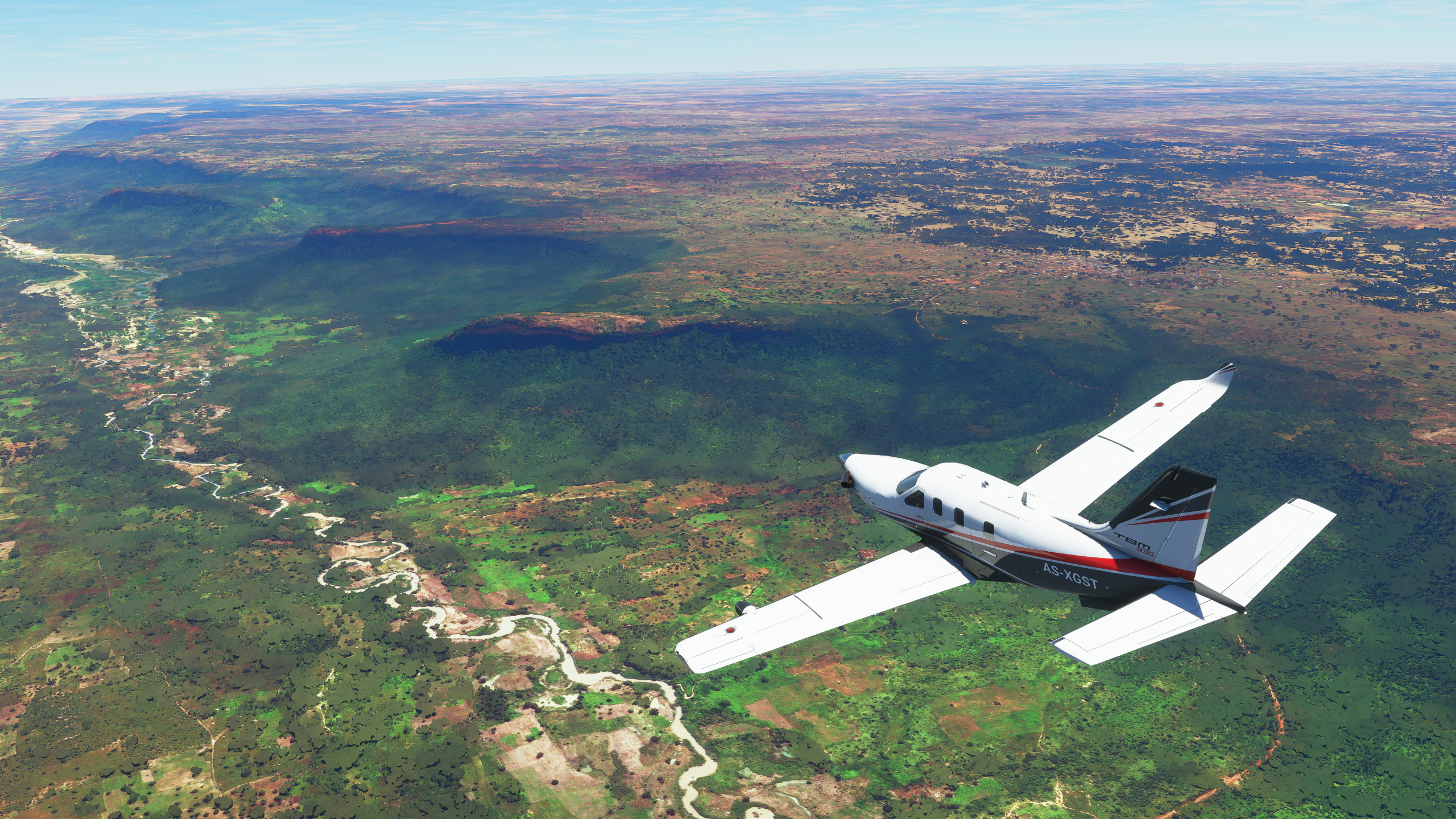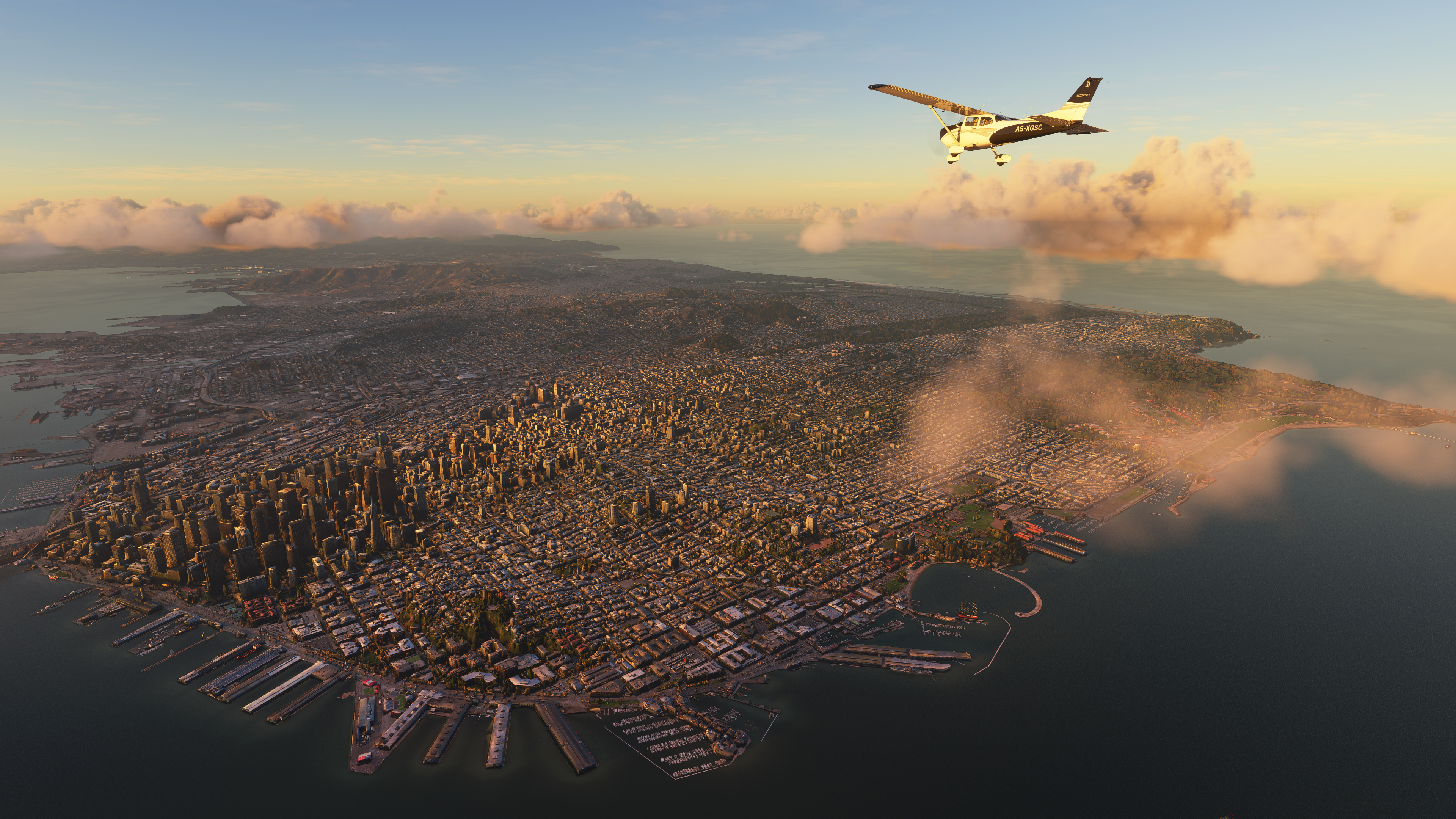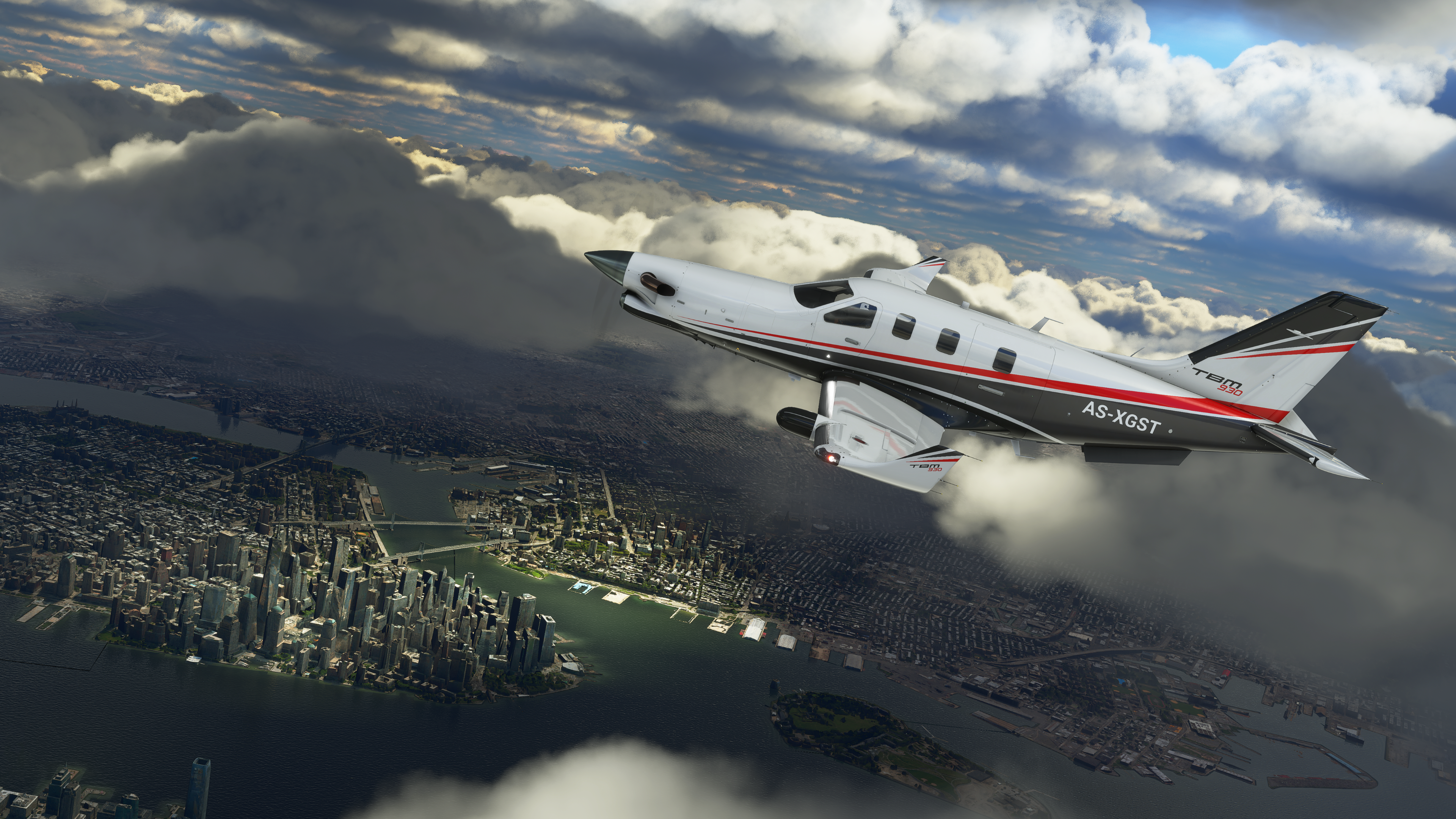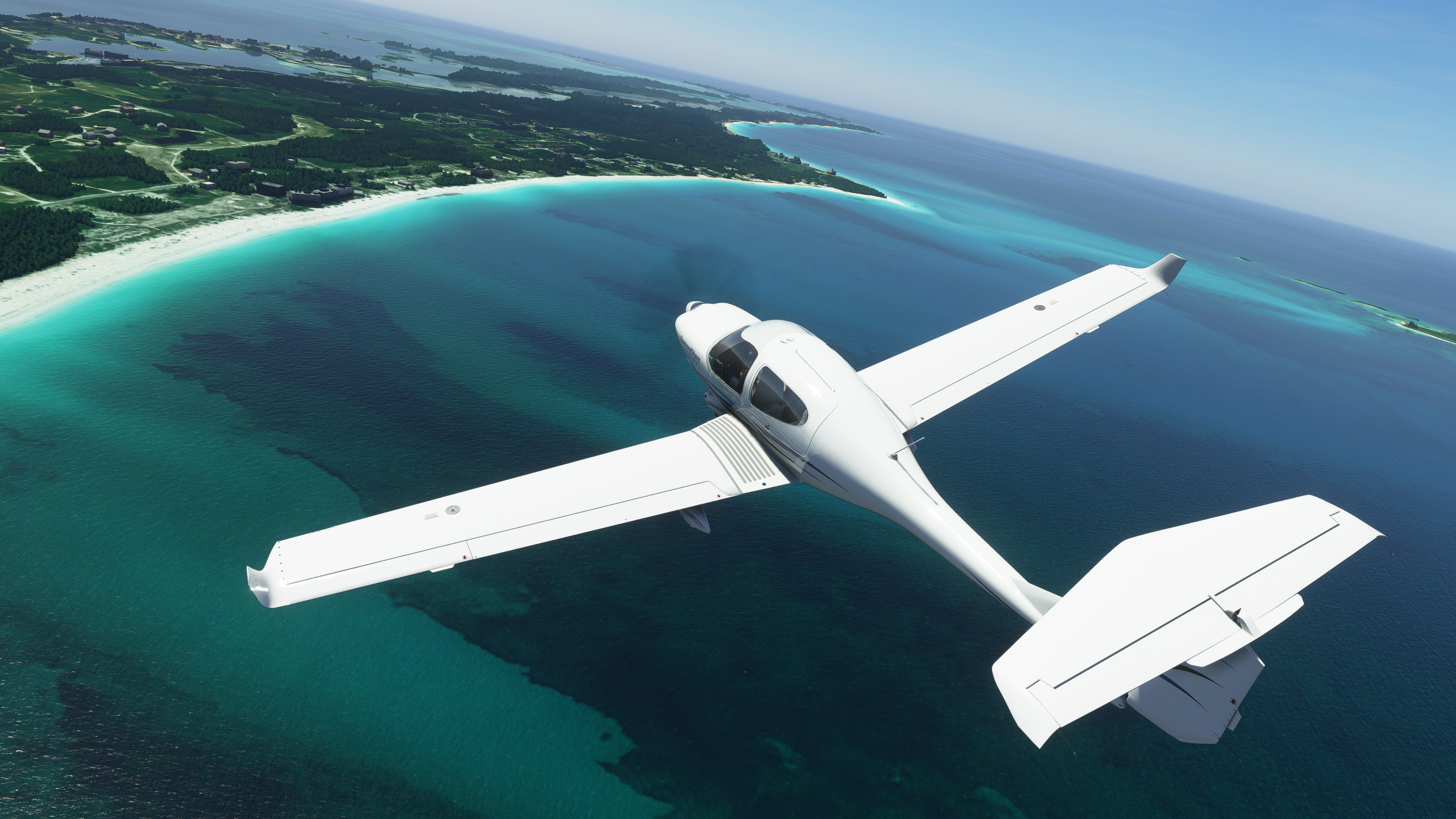Fly anywhere in the world in the impossibly massive Microsoft Flight Simulator
Microsoft takes its classic sim to new heights.

My tiny Cessna light aircraft is barrelling down the terrifyingly short runway at Lukla, an airport nestled in the mountains of eastern Nepal that's said to be one of the most dangerous in the world. The end of the runway approaches fast as I yank back on the yoke, but I'm not getting any lift. I resign myself to my fate, but half a second before I slam into the barrier separating Lukla from the misty void below, the little plane lurches into the air and suddenly I find myself soaring down a deep, vast Himalayan valley scattered with fluffy clouds.
Ten minutes later I'm flying over New York City, a dense urban sprawl that stretches as far as the eye can see, sunlight glinting off the skyscrapers. Then I'm above my hometown of Glasgow, Scotland in the thick of a torrential rainstorm. I can see the streets where I grew up below me. Then I'm somewhere over the Sahara. The Jökulsárlón glacier in Iceland. The lush valleys of New Zealand. Mount Fuji in Japan. Anywhere I can think of I can go, because in Microsoft Flight Simulator the entire world is literally at your fingertips.
It seems unbelievable, but as I spin a 3D globe around I realise that I can drop my plane anywhere on Earth and, after a short loading screen, start flying. This is possible because the game generates its world using satellite data pulled from Bing Maps. But you aren't just flying over a flat texture: the engine takes this map data then intelligently fills it in with trees, water, buildings, and even little details such as traffic on the roads. Elevation is rendered accurately too, resulting in towering mountain ranges and yawning valleys.

Scattered across the globe are white dots representing tens of thousands of real-world airports. There are famous ones such as the aforementioned Lukla, New York's JFK, or London Heathrow. But there are countless smaller ones too, including Mataveri on Easter Island, the most remote airport in the world. I even managed to find and take off from RAF Linton-on-Ouse, a military airfield near me that I became aware of when I noticed fighter jets constantly flying over my house. And then I flew over my house. You can start at an airport or just click somewhere on the planet and appear in the sky mid-flight.
It's exhilarating being able to pick somewhere on the planet and almost instantly fly there. Like when you spin a globe, jab your finger on it to stop it, and fantasise about going wherever your digit happened to land—except here you can realise that fantasy, albeit virtually. You also have fine control over the weather and time of day, so if you want to cross the Atlantic during a thunderstorm, fly over Seoul at night, or cruise along the Alps at sunset, all you have to do is drag a few sliders then select that place as your starting point. You can change the weather and time of day in-game too, so if you're bored of clear skies you can call in a supercell to spice things up.
You can even use live weather data, meaning that if it's raining in London in real life, it'll be raining in the game too. Weather simulation is another thing that adds to the realism, with storms and other meteorological phenomena that don't just look and behave like they do in real life, but appropriately affect the handling of your plane as well. And thanks to a ridiculous 600km draw distance, it's possible to see storms long before you fly into them. If you get trapped in one, the dark, fat volumetric clouds around your plane are illuminated by cracks of lightning, which is as nerve-racking as it sounds.
The Microsoft Flight Simulator development team seems particularly proud of its clouds, and rightly so. They're colossal, voluminous, three-dimensional things, refracting and catching the light, swelling with darkness as rain accumulates, and drifting over the landscape, casting immense shadows as they go. Clouds can even cast shadows on other clouds. The result is some of the finest skies I've ever seen on PC, and skies that are all the more impressive for being colossal simulations of intricate weather systems, not just pretty skyboxes.
The biggest gaming news, reviews and hardware deals
Keep up to date with the most important stories and the best deals, as picked by the PC Gamer team.
See Microsoft Flight Simulator in action above.
Sims can be quite drab and lifeless, often trading visual fidelity for realism. But details like these make Microsoft Flight Simulator not only beautiful to look at, but powerfully atmospheric too. And that is, for me, one of the most exciting things about it. It has all the things a hardcore simulator fan demands from a game like this: licensed planes, realistic aerodynamics, simulated weather, icing, load factor, fuel consumption, thermic updrafts, and native support for a wide variety of sticks, yokes, and throttles. But the game doesn't merely want to replicate the cold, mathematical reality of flying, but the drama and romance of it too. It's flight as an experience, not just a series of calculations.
When you're cruising over the Seattle skyline as the sun dips below the horizon, casting a golden glow over the city, or you're soaring above Tokyo at night, an endless sea of lights stretching below you, this feeling is palpable. It reminds you that flying is an incredible, special thing. Granted, this is difficult to appreciate when you're squeezed into an economy seat, drinking a tiny can of Heineken, watching a below average Kevin Hart film. But when you're at the yoke of a plane in Microsoft Flight Simulator, free as the wind, it's utterly blissful. Now I understand why people get so hooked on aviation, and why many of the development team have started taking flying lessons.
Those remarkable visuals will undoubtedly result in a lot of new players drifting towards Microsoft Flight Simulator—even if they have no real interest in sim games. Microsoft is well aware of this and is promising an experience that can be heavily customised, whether you're the type of dedicated virtual pilot who has a plywood cockpit in their spare room, or someone who just wants to sprawl on the couch with a gamepad. A large number of assists can be switched on or off, making flying as simple or complex as you like, or some combination of the two, perhaps. However, no matter how many assists you have enabled, the game will still use the same base aerodynamics simulation.

If you're wondering how your PC is going to cope with rendering the entire world, developer Asobo Studio explains that Microsoft Flight Simulator will rely on your internet connection, using something called adaptive streaming. The better your bandwidth, it says, the greater visual fidelity you'll experience. But the developer is also keen to stress that there will be an offline mode where you can pre-cache parts of the map to fly on without being connected to the internet. But it sounds like playing online will offer the best experience, and will let you enjoy features such as finding real planes in the sky using live flight tracker data, then diving in and taking over the controls.
Of course, a game attempting to recreate the whole planet is never going to be perfect. Even though the pre-alpha build of the game I played was impressively stable, and obscenely pretty, the world generation did have some issues. Occasionally it seemed as if the engine hadn't properly processed or identified certain parts of the map, resulting in glitchy terrain, traffic driving into rivers, and other weirdness. I also encountered a few airports where the runway seemed to be in the sea, or just didn't exist at all. And it's pretty obvious when you get really close to the ground that it's all based on satellite maps.
But a developer reassured me that the procedural systems which detect and fill these details in are still being worked on, and that most of these bugs will eventually be ironed out. Still, they say, they couldn't possibly check every corner of the world for inconsistencies. It's so big that even they haven't, and likely never will, see certain parts of it. However, you do spend most of the game miles in the air, where it looks basically photorealistic when the weather and lighting are just right. So I'm sure most people, myself included, will be willing to endure the odd graphical quirk in light of everything else the game is doing.
Honestly, I think I'm most excited about Microsoft Flight Simulator as a relaxation tool. I'll dive into the simulation, sure, but I can see myself playing it mostly for the same reason I play Euro Truck Simulator 2: as a way to zen out. Some of the developers I spoke to acknowledged this, saying they often play this way themselves. Turn on the assists, pick a pretty part of the world, and just enjoy the ride. As big and wonderful as Euro Truck is, this definitely has it beat (and every other sim, for that matter) in terms of the sheer variety of locations on offer. I played the preview build for around four hours and I felt like I'd barely dipped my toes in the pool. There's so much to discover here and I can't wait to spin that globe again and see where the wind takes me.

If it’s set in space, Andy will probably write about it. He loves sci-fi, adventure games, taking screenshots, Twin Peaks, weird sims, Alien: Isolation, and anything with a good story.


